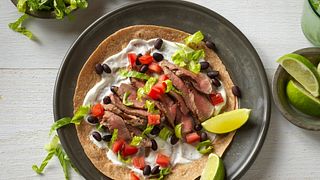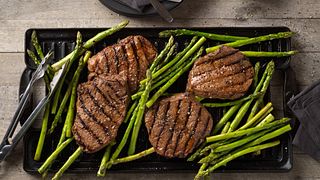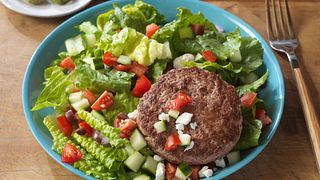Protein - Essential for Life
Beef is known to be an excellent source of protein. But what exactly is protein and why is it important?
Protein 101
Proteins, along with carbohydrates and fats, comprise the three macronutrients that, when broken down (digested), supply energy to our bodies in the form of calories. Proteins have several important functions including providing structure to all cells of the human body, functioning as enzymes, transport carriers and hormones.1
Amino acids are the building blocks of protein. If amino acids are the letters of the alphabet, proteins are the words they form. There are 20 amino acids, nine of which are essential – meaning the body cannot generate them on its own.1
Protein quality is a term used to describe a protein that has sufficient amounts of all nine essential amino acids. It can be measured by the Digestible Indispensable Amino Acid Score (DIAAS), which describes protein quality on the basis of ileal digestibility; or by the Protein Digestibility Corrected Amino Acid Score (PDCAAS) scoring system.2,3 Generally speaking, proteins that come from animal sources such as beef, poultry, fish, eggs or dairy are complete, or high-quality, proteins, whereas most plant sources of protein tend to lack one or more essential amino acids and are thus considered “incomplete” proteins.2,3
Benefits of Protein
Not only is protein beneficial from a structure/function perspective, but research also shows certain health benefits associated with protein:
- Weight management: Research has found that high-protein diets are effective at promoting weight loss and maintaining lean body/muscle mass.4-6
- Satiety: People who eat a higher-protein diet (about 30% of daily calories from protein) feel fuller, which may help prevent overeating.7
- Muscle growth/repair: Physical activity is more effective when paired with a proteinrich diet.8,9 It is well known that protein consumed after exercise provides the amino acids necessary for muscle repair and recovery, helping to stimulate further muscle synthesis.9 Evidence also suggests that a protein-rich diet combined with resistance exercise helps adults become more toned by helping them lose fat and maintain muscle mass.8,9
- Healthy aging: Reductions in muscle mass (i.e. sarcopenia) is common as people age. Emerging research suggests that higher protein intake among older adults may reduce or prevent age-related muscle decline.10
Protein Pacing
In addition to consuming enough protein in a day, emerging research suggests that for optimal benefits, protein intake should also be paced throughout the day. Currently, the majority of protein is eaten at dinner (42%), followed by lunch (28%), and then breakfast (16%).11 Snacks, which may be spread throughout the day, make up the difference.11
According to recent research, consuming 20 to 30g of protein per meal may optimize skeletal muscle synthesis.12,13 Assuming three meals per day, protein intake would still be well below the recommended upper limits for protein or essential amino acids for healthy persons.
Beef Provides high-quality protein
When it comes to choosing protein, not all food sources are created equal. Animal proteins, such as lean beef, provide complete high-quality protein that contains all the essential amino acids the body needs for optimal health. To get the same amount of protein found in lean meat from most plant proteins, such as beans, nuts and grains, results in consuming 1½ to 2 times more calories. For example, a 3-oz serving of lean beef (about 150 calories on average) provides about the same amount of protein as 1½ cups of cooked black beans (341 calories) in less than half the calories.14 Lean beef is also a top source of readily absorbable iron and zinc and an excellent source of vitamin B12, an essential nutrient not naturally available in plant protein sources.14
The benefits of consuming beef have been extensively studied. A recent paper published in Obesity Science & Practice shows that as part of a healthy and higher-protein diet, lean beef can help people lose weight while maintaining muscle and a healthy heart.15
Recommendations for health professionals
A smart strategy that health professionals can utilize is to help consumers pace their protein intake throughout the day, paying particular attention to breakfast when protein intake tends to be at its lowest. Health professionals who advise older adults should also emphasize protein intake to help to prevent sarcopenia.
Beef is an excellent protein source as consumers seek to boost their protein intake, given it’s a complete protein supplying all nine essential amino acids, and is associated with weight maintenance and heart health.
Educational resources
Here are a few free resources which may be useful for both health professionals and their clients:
Fact Sheet: Get Lean with Protein
- Turnkey Presentation: The Science of Protein
- Handout: The Power of Protein
- White Paper: Protein Summit 2.0
- Handout: Stock Your Protein Pantry
- Institute of Medicine. Dietary Reference Intakes for Energy, Carbohydrate, Fiber, Fat, Fatty Acids, Cholesterol, Protein, and Amino Acids. Washington, DC: The National Academies Press, 2005.
- Phillips SM, et al. Commonly consumed protein foods contribute to nutrient intake, diet quality, and nutrient adequacy. Am J Clin Nutr 2015;101:1346S–52S.
- Food and Agriculture Organization of The United Nations (FAO) Expert Consultation. Dietary protein quality evaluation in human nutrition. FAO food and nutrition paper 92. Available at: http://www.fao.org/ag/humannutrition/35978-02317b979a686a57aa4593304ffc17f06.pdf
- Kim JE, et al. Effects of dietary protein intake on body composition changes after weight loss in older adults: a systematic review and meta-analysis. Nutr Rev 2016;74: 210–24.
- Santesso N, et al. Effects of higher- versus lower-protein diets on health outcomes: a systematic review and metaanalysis. Eur J Clin Nutr 2012;66:780–88.
- Wycherley TP, et al. Effects of energy-restricted high-protein, low-fat compared with standard-protein, low-fat diets: a meta-analysis of randomized controlled trials. Am J Clin Nutr 2012;96:1281–98.
- Paddon-Jones D, et al. Protein, weight management, and satiety. Am J Clin Nutr 2008;87:1558S-61S.
- Layman D, et al. Dietary protein and exercise have additive effects on body composition during weight loss in adult women. J Nutr 2005;135:1903-10.
- Rodriguez N, et al. Dietary protein, endurance exercise, and human skeletal-muscle protein turnover. Curr Opin Clin Nutr Metab Care 2007;10:40-5.
- Paddon-Jones D, et al. Protein and healthy aging. Am J Clin Nutr 2015;101:1339S–45S.
- U.S. Department of Agriculture, Agricultural Research Service. What We Eat in America, NHANES 2013-2014, individuals 2 years and over (excluding breast-fed children), day 1. Available at: www.ars.usda.gov/nea/bhnrc/fsrg
- Paddon-Jones D, Rasmussen BB. Dietary protein recommendations and the prevention of sarcopenia. Curr Opin Clin Nutr Metab Care 2009;12:86-90.
- Mamerow MM, et al. Dietary protein distribution positively influences 24-h muscle protein synthesis in healthy adults. J Nutr 2014;144:876-80.
- U.S. Department of Agriculture, Agricultural Research Service, Nutrient Data Laboratory. USDA National Nutrient Database for Standard Reference, Release 28 (Slightly revised). 2016. Available at: http://www.ars.usda.gov/ba/bhnrc/ndl
- Sayer RD, et al. Equivalent reductions in body weight during the Beef WISE Study: Beef’s Role in Weight Improvement, Satisfaction, and Energy. Obes Sci Pract 2017. Available at: http://onlinelibrary.wiley.com/doi/10.1002/osp4.118/full







